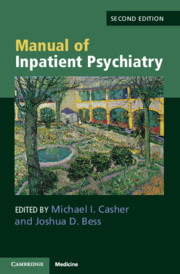Book contents
- Manual of Inpatient Psychiatry
- Manual of Inpatient Psychiatry
- Copyright page
- Contents
- Contributors
- Preface to the Second Edition
- Foreword: American Inpatient Psychiatry in Historical Perspective
- Chapter 1 The Inpatient with Schizophrenia
- Chapter 2 The Inpatient with Depression
- Chapter 3 The Inpatient with Mania
- Chapter 4 The Inpatient with Borderline Personality Disorder
- Chapter 5 The Inpatient with Dementia
- Chapter 6 The Inpatient with Traumatic Brain Injury
- Chapter 7 The Inpatient with Dual Diagnosis (Co-Occurring Disorder)
- Chapter 8 The Young Adult on the Inpatient Unit
- Chapter 9 Clinical Documentation on the Inpatient Unit
- Index
- References
Chapter 1 - The Inpatient with Schizophrenia
Published online by Cambridge University Press: 05 March 2020
- Manual of Inpatient Psychiatry
- Manual of Inpatient Psychiatry
- Copyright page
- Contents
- Contributors
- Preface to the Second Edition
- Foreword: American Inpatient Psychiatry in Historical Perspective
- Chapter 1 The Inpatient with Schizophrenia
- Chapter 2 The Inpatient with Depression
- Chapter 3 The Inpatient with Mania
- Chapter 4 The Inpatient with Borderline Personality Disorder
- Chapter 5 The Inpatient with Dementia
- Chapter 6 The Inpatient with Traumatic Brain Injury
- Chapter 7 The Inpatient with Dual Diagnosis (Co-Occurring Disorder)
- Chapter 8 The Young Adult on the Inpatient Unit
- Chapter 9 Clinical Documentation on the Inpatient Unit
- Index
- References
Summary
Patients with schizophrenia who meet criteria for admission to an inpatient unit are generally quite ill. The so-called positive symptoms of schizophrenia, which can result in threatening behavior and loss of control, are the usual triggers for admission. Some admitted patients will be experiencing a first episode of illness (“first break”), while others are hospitalized with an exacerbation of preexisting schizophrenia. The most obvious – and most disruptive – symptoms are generally related to psychosis, with the loss of reality testing and impaired mental functioning [1, 2]. Psychosis usually presents with hallucinations, delusions, disorganized thinking, and/or bizarre or disruptive behavior (Table 1.1). The onset of illness or worsening of psychotic symptoms may be noticed by a family member, friend, teacher, coworker, employer, or caregiver who sees the patient behaving bizarrely and deteriorating in their ability to function. A patient may be so disruptive in the community that he or she is brought to the emergency department by the police.
- Type
- Chapter
- Information
- Manual of Inpatient Psychiatry , pp. 1 - 27Publisher: Cambridge University PressPrint publication year: 2020

